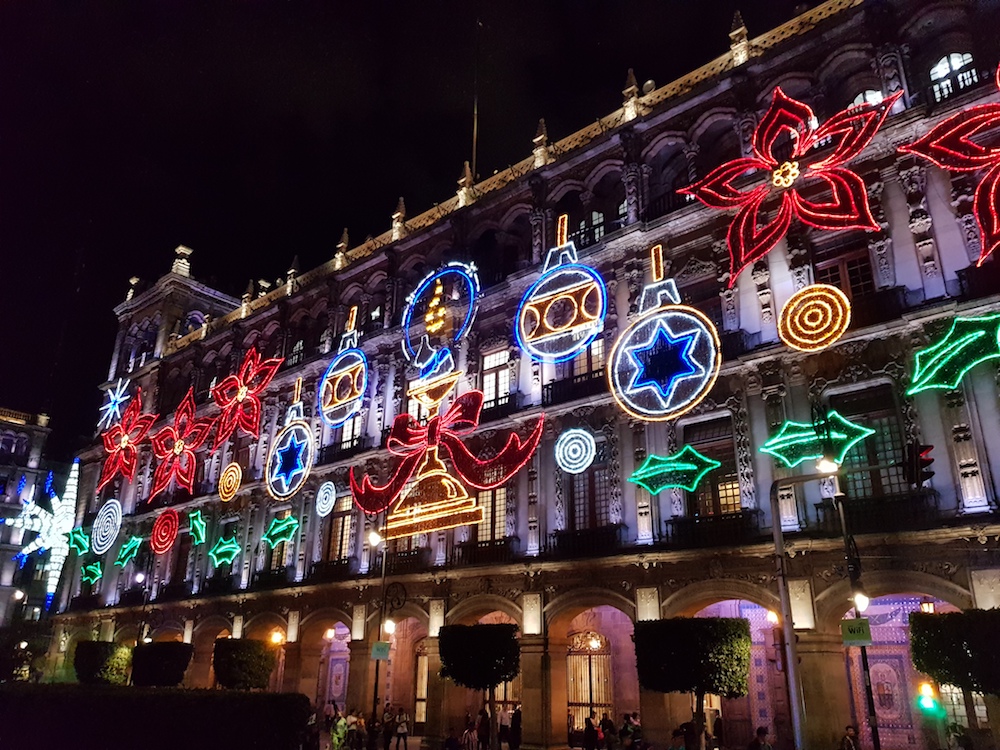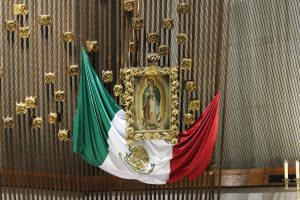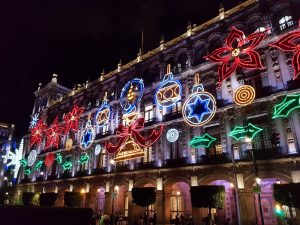
Spending Christmas in Mexico is a very special experience. This family celebration is celebrated in Mexico quite differently than here in Germany. Therefore, in this article some of the most important characteristics of Christmas in Mexico would like to share with you. Starting with the pre-Christmas period, traditional food and other small specialties.
Pre-Christmas period in Mexico
The pre-Christmas period is somewhat less contemplative than in other places. You look will wait in vain for an Advent season like in Germany or Christmas markets. But in all big department stores, supermarkets and even in small shops you can find aggressive Christmas offers with up to 40 or 50% discount. The festival of love is also the festival of shopping after all 😉 – Meanwhile Christmas trees also play a big role in Mexico and can be seen at people’s homes as well as in shopping malls and stores everywhere.
In the middle of December the festival of the Virgin of Guadalupe are celebrated. This festival is celebrated with exploding rockets, loud music and lots of alcohol. The celebrations begin around December 10th and culminate on December 12th with processions in most of the Mexican towns and villages. Also in other countries of Central America like Guatemala the Virgin of Guadalupe is honored and celebrated.
In the following video you can get an impression of these processions:
The background of the Virgin of Guadalupe celebrations is very religious. It is a historical image of Mary that is very widespread in Mexico. Between the 9th and 12th of December 1531, in the Guadalupe neighborhood in the north of Mexico city, the Indigenous Juan Diego Cuauhtlatoatzin saw a woman appear 4 times, according to tradition, who called herself “Mary, the mother of the only true God […]”. The place of pilgrimage site Villa de Guadalupe is still located on the mountain Tepeyac.
This apparition of Mary asked Juan Diego to inform the local bishop that a chapel should be built on the mountain Tepeyac where she appeared. There she wanted to give her love to the people. The bishop doubted the report and asked for a sign. One day later, the Indigenous came back and had collected blooming flowers in the middle of winter by order of Mary. He had wrapped them in his coat and on this same coat the image of the Virgin of Guadalupe appeared. Thereby the bishop recognized the authenticity of the apparition and fulfilled the wish to build a chapel. The Virgen Guadalupe is the most important Marian Shrine in Mexico and is one of the most famous miraculous images in the world. Accordingly, there are also all kinds of decorative articles with the Virgin Guadalupe as a motif*.

Another rather crazy tradition is the Maratón Guadalupe-Reyes. It begins on 12th of December and continues until 6th of January – the day of the three wise men. This day is also celebrated in Mexico in a special way. On this day the children receive gifts such as toys or sweets, since the three wise men also offered gifts the newborn Baby Jesus. In addition, in some churches and families, a total of 9 posadas (celebrations) are organized from December 16-24, the highlight of which is December 24. So around Christmas in Mexico many more celebrations are held and people drink much more intensively than in Europe or the US.
The Maratón Guadalupe-Reyes is also generally considered by students and party lovers as the time of the year when people drink a lot. Accordingly one should spend drunk every day from 12th of December and until 6th of January. This “tradition” began in the 90s and was even immortalized in a film in which two old friends in their 40s try this marathon together once again. Here is the trailer (in Spanish):
Illuminated Christmas in Mexico
From December onwards, all sorts of things will also be illuminated. In the same style as in the neighboring country USA. You will find houses with the classic reindeer and Santa Claus as well as buildings, walls, trees or bushes covered with light chains* – in all possible colors and shapes – with flashing lights or continuously illuminated. What has only become more and more widespread in other countries in recent years has long been a traditional part of Christmas in Mexico. However, houses like this one are among the more extreme forms:

But not only private houses are decorated with artistic light art. Public places, department stores and government buildings are also solemnly illuminated. There are even department stores that underline their light art with (classical) music. Some of the lights even flash to the rhythm of the music. I was especially impressed by the lighting at the Zocalo in Mexico City:

Christmas in Mexico with traditional food
In general the food is eaten much later at Christmas in Mexico than in other countries. Depending on the family even as late as after midnight mass, but usually not before 10 pm. The food itself also differs considerably from many traditions known in Europe. Traditional Christmas dishes are for example:
Ensalada de Manzana (apple salad)
The traditional apple salad contains apples, nuts, raisins, cranberries, condensed milk, Lechera* and, depending on the recipe, some yoghurt. The apple salad is served as dessert. It is usually served with Ponche.
Ponche (Punch) with fruits
The traditional Christmas punch contains guave, apples, Tejocote (an endemic fruit related to the hawthorn), cinnamon, tamarind, pineapple and cut sugar cane. The fruits remain in the punch. There is also a version for adults with a toque (electric shock). This version contains tequila.
Romeritos
A traditional dish in Central Mexico that consists of romeros (a type of plant), nopal cactus, dried shrimp and small boiled potatoes.
Bacalao
Bacalao is the Spanish name for cod (fish). It is usually bought dried and then soaked for at least one day. It is prepared with various sauces and vegetables. The variety of recipes is gigantic!

En Valdavia – Trabajo propio, CC BY-SA 3.0, Enlace
Stuffed turkey or chicken
In addition to traditional Mexican dishes, stuffed turkey or chicken has become a popular alternative. There are also different ways of preparing the stuffing and sauce, for example with meat, chillies, orange, nuts, vegetables etc.

